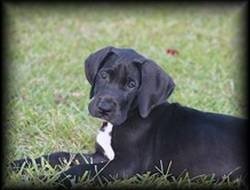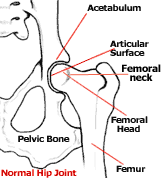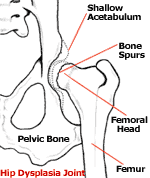
|

|
|
|
| ||
Hip Dysplasia in DogsHip dysplasia in dogs is the most common cause of rear leg lameness in dogs.  The highest incidence occurs in large-breed dogs, including St. Bernards, Newfoundlands, Rottweilers, Chesapeake Bay Retrievers, Golden Retrievers, German Shepherd Dogs, Labrador Retrievers, and Great Danes. Smaller breeds are also affected, but are less likely to show symptoms. Hip dysplasia in dogs is one of the most studied veterinary conditions in dogs, and the most common single cause of arthritis of the hips. Hip dysplasia is a polygenic trait. That is, more than one gene controls the inheritance. Environmental factors such as diet are also involved. The hip is a ball-and-socket joint; the ball is the head of the femur and the socket is the acetabulum of the pelvis. In a dysplastic hip, the head of the femur fits loosely into a poorly developed, shallow acetabulum. Joint instability occurs as muscle development lags behind the rate of skeletal growth. As the stress of weight bearing exceeds the strength limits of the supporting connective tissue and muscle, the joint becomes loose and unstable. This allows for free play of the femoral head in the acetabulum, which promotes abnormal wear and tear.  Feeding a very high-calorie diet to growing dogs can exacerbate a predisposition to hip dysplasia, because the rapid weight gain places increased stress on the hips. Being overweight supports the genetic potential for hip dysplasia, as well as other skeletal diseases. A diet with an imbalance of calcium and phosphorous is bad for bone development. Another factor that can bring on the symptoms of hip dysplasia in dogs is inappropriate exercise during the period of rapid bone growth. Young dogs should be discouraged from jumping up and down from heights in situations where they land on their back legs (such as jumping up to catch a ball), and from standing up on their back legs (which dogs do when they stand up against a fence or window to get a better view). They should also avoid running on pavement. Signs of Hip Dysplasia in DogsSigns of hip dysplasia are lameness, reluctance to exercise, and muscle atrophy. It can be confirmed with an X-ray of the hips and pelvis. Dogs with mild hip dysplasia can often get along well with the help of nutraceuticals and pain-relieving medications. In the case of dogs with severe hip dysplasia, total hip replacement is the treatment of choice. Other hip surgeries may be recommended depending on the dog’s specific conditions. Dogs with hip dysplasia are born with hips that appear normal but progressively undergo structural changes. The age of onset is 4 to 12 months. Affected puppies may show pain in the hip, walk with a limp or a swaying gait, bunny hop when running, and experience difficulty in the hindquarters when getting up. Pressing on the rump can cause the pelvis to drop. With the puppy on his back, the rear legs may not extend into the frog-leg position without causing pain. In a dog with severe hip dysplasia, the head of the femur is completely out of the joint and arthritic changes are marked. Once arthritis is noted, the condition is irreversible. But even with arthritis, some dogs are not lame. The onset of lameness is unpredictable, and some dogs may go most of their lives with dysplastic hips but no lameness. Others develop lameness as puppies. TreatmentsHip dysplasia in dogs is treated both medically and surgically. Medical treatment includes restricting activity and giving and NSAID analgesic such asRimadyl, and a joint chondroprotectant such as Cosequin or Adequan to relieve pain and inflammation and to repair damaged cartilage. Weight loss and moderate exercise are are also important. It is important to exercise lame dogs on a leash and not allow them to run, jump, or play asw long as they exhibit pain. Swimming is an excellent exercise that improves muscle mass and joint flexibility wihout overstressing the hips. Non-surgical interventions include three elements: weight control, exercise control, and medication. Weight control is often The single most important thing that we can do to help a dog with arthritis, and consequentially reducing the dog's weight is enough to control all of the symptoms of arthritis in many dogs. Reasonable exercise stimulates cartilage growth and reduces degeneration (though excessive exercise can do harm too), and also regular long walks in early or mild dysplasia can help prevent loss of muscle mass to the hips. Medication can reduce pain and discomfort, and also reduce damaging inflammation. Sign up for Great Dane Dog World's NewsletterHolistic MethodsHolistic methods to reduce the effects of hip dysplasia
Reference: Wikipedia the Online Encyclopedia, Dog Owners Home Veterinary Handbook, Dog Channel and Dog Bible Table of Contents
Homepage | Best Dog for Kids | Animal Rescue Site | Link to Us
Great Dane Puppies | Great Dane History | Great Dane Introduction | Therapy Dogs | Great Dane Training | Great Dane Dogs | Great Dane Blog | Great Dane Care | Pack Leader | Volvulus Bloat Scale | Ear Cropping | Bloat | Helpful Links | Harlequin | Puppy Mills | | Click Here To Visit Kittys Corner  Click Here to Vote for My Site! Click Here to Vote for My Site!
If you find this website useful, please consider helping its production with a donation. Click the Donate button to go to the safe and secure PayPal 
~Kittys Corner~I have a Female Great Dane and her name is Kitty. She will be 2 in July '10. Her mother is a Blue Dane and her dad is a Black Dane. This is a picture of her here and there are lots of pictures of her on this website. This space is called Kittys Corner because when ever I am at my computer working (which is most of the time) Kitty is laying or sitting beside me with her head on my lap. So I made her a corner so she can voice what is going on in her world. ~Enjoy~The weather is so warm and sunny. I was getting tired of the cold and being stuck in the house. Now mom has been back taking me on our walks I missed our walks. Have you been doing anything fun lately? Will you send me your pictures so I can see them? Mom even said something about starting a contest. How fun! So start taking some pictures, or if you already have some, send them in so I can see them. Send in a Picture 
| |
| | ||
Hip Dysplasia in Dogs Beginning Welcome to the World of the Great Dane.This website strives to bring you the latest information on Great Danes. The content is updated often so make sure and bookmark this site so you can keep up to date on the information. Link To UsReturn to top The Content of this Website is intended as General Information and is NOT Professional Advice. | ||
| | ||


